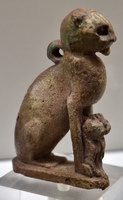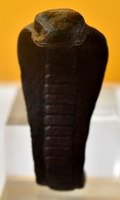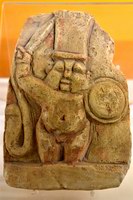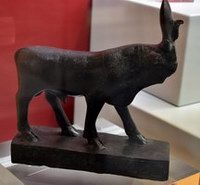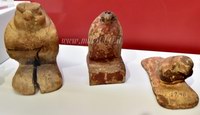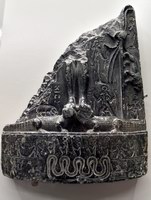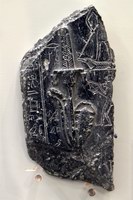Indice dei Musei
presenti in miti3000
Napoli Museo Nazionale - Piano -1 - Sala XXII
- Intro sala XIX
- Sala XIX
- Intro sala XX
- Sala XX
- Intro sala XXI
- Sala XXI vetrina 49
- Sala XXI vetrina 50
- Sala XXI vetrina 51
- Sala XXI vetrina 52
- Sala XXI vetrina 53-54
- Sala XXI vetrine 55-56
- Sala XXI vetrine 57 - 58
- Sala XXI vetrine 60 - 61
- Sala XXI vetrine 62 - 63
- Intro Sala XXII
- Sala XXII vetrine 70 - 78
- Sala XXII vetrine 79 - 84
- Intro Sala XXIII
- Sala XXIII v.87-92
- Sala XXIII v.93-97
- Sala XXIII v.98-104
Testo
Sala XXII - vetrine 79 - 84
Posiziona il mouse sulle immagini per avere pi¨ informazioni, Cliccaci sopra per l'ingrandimento.
Place the mouse on the images to get more information, click on it to enlarge
Vetrina 80
|
|
|
|
|
|
Vetrina 81
MAGIA
La magia permeava profondamente il mondo degli Egiziani ed era presente nei rituali religiosi come nella pratica medica.
Il suo strumento primario era la parola associata ad azioni precise che potevano accompagnare i gesti del sacerdote quando si rivolgeva al dio o quelli del medico, quando curava un malato.
Particolari formule accompagnavano inoltre il defunto per assisterlo nell'oltretomba, mentre altre erano iscritte sulle stele arpocratee o sulle statue magiche per aiutare i vivi in situazioni critiche.
Magic
Magic was an important part of the world of the Egyptians. It was used both in religious rites and in medical practice.
Its primary instrument was the word, in association with certain actions performed by the priest when he addressed the gods, or the doctor when he cured a patient.
The dead brought with them in the tomb special spells to protect them in the afterlife.
Further spells were written on Horus stelae or magical statues to protect the living from danger.
Vetrina 81
VETRINA 82
Frammento di lastra con Iside

Marmo, Epoca Romana (30 a.C. - 395 d.C.). Collezione Borgia, inv. 1078
La dea Ŕ raffigurata con un elaborato copricapo formato dalla corona atef (corna bovine, disco solare, due piume) e doppio ureo, simbolo delle due divinitÓ femminili tutelari dell'Alto e Basso Egitto Nekhbet e Wagit rispettivamente.
Fragment of a relief with Isis
Marble. Roman Period (30 BC-395 AD). Borgia collection. inv. no. 1078
Isis is represented with the atef crown (horns. sun disk and two feathers) with a double uraeus, symbol of the female goddesses Nekhbet and Wadjit, patrons of respectively Upper and Lower Egypt.
Vetrina 83
Stele arpocratea-amuleto
Calcare. XXV-XXVI Dinastia (747-525 a.C.) Collezione Borgia, inv. 1012.
Stele rettangolare che veniva portata al collo con finalitÓ di protezione.Presenta una singolare raffigurazione di Arpocrate parzialmente di profilo, in piedi su due coccodrilli incrociati, che tiene nelle mani due serpenti, uno scorpione ed un orice.
Horus stela-amulet
Limestone. 25th-26th Dynasty (747-525 BC). Borgia collection, inv. no. 1012
Rectangular stela (usually worn on the neck as protective charm) showing Harpocrates partially on a side perspective above two crocodiles, holding in his hands two snakes, a scorpion and an oryx.
VETRINA 84
Falco
Calcare. Epoca Tarda (664--332a.C.). Collezione Borgia, inv. 426
Statua di falco stante, con testa e copricapo largamente consumati ed ali chiuse a formare un unico blocco con la base rettangolare.
Hawk
Limestone. Late Period (664-332 BC). Borgia collection, inv. no. 426
Statue of a hawk with folded wings and badly damaged head, perched on a rectangular base.
Statua magica
Basalto. Epoca Tarda (664-332 a.C.). Collezione Borgia, inv. 1065
Statua mutila di guaritore decorata con immagini di divinità e formule magiche, i cui poteri terapeutici si trasferivano all’acqua che veniva versata sulla superficie, per essere poi utilizzata come medicamento o agente di prevenzione.
Magic statue
Basalt. Late Period (664-332 BC). Borgia collection, inv. no. 1065
Fragmentary statue of a healer, decorated with a procession of deities and magical formulas. Those statues were usually poured with water in order to absorb the therapeutic quality of the texts, to be used for cure or protection.
Situla
Bronzo. Epoca Romana (30 a.C.-395 d.C.). Collezione Borgia, inv. 724
Vaso globulare decorato a rilievo con una processione di divinita. La forma ricorda una mammella, dispensatrice di vita, ed è connessa alla rigenerazione tramite liquidi vitali come acqua e latte, nonché al culto della dea Iside.
Situla
Bronze. Roman Period (30 BC-395 AD). Borgia collection, inv. no. 724
Globular vase decorated with a parade of divinities. The breast form (life giving) is strictly connected to regeneration through vital liquids such as waterand milk, as well as to the Isis’ cult.
fotografie Giorgio Manusakis



